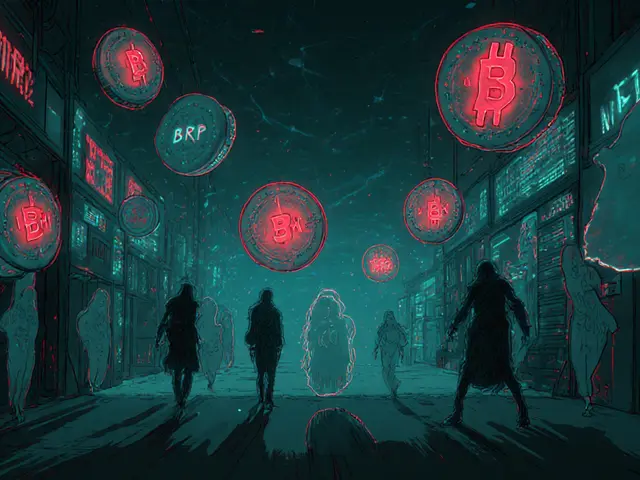EtherFlyer DEX Comparison Tool
EtherFlyer
Launched 2017 • Non-operational
InactiveVertex.Market
Launched 2021 • Active
ActiveUniswap
Launched 2018 • Active
Active| Metric | EtherFlyer | Vertex.Market | Uniswap |
|---|---|---|---|
| Launch Year | 2017 | 2021 | 2018 |
| Jurisdiction | Samoa | Estonia | Decentralized |
| Average Daily Volume (USD) | Not tracked / N/A | $12M | $1.6B |
| Listed Pairs | Unknown | ≈150 | ≈6,300 |
| User Rating (out of 5) | 3 (2 reviews) | 4.7 (6 reviews) | 4.5 (Thousands) |
| Current Status | Non-operational | Active | Active |
What to Look For in a Reliable DEX
- 1 Transparent trading volume and liquidity data
- 2 Active user community and regular updates
- 3 Clear jurisdiction and compliance policies
- 4 Strong security practices and audits
- 5 Support for multiple wallet types
Ever wondered why a crypto exchange that launched right before the 2017 boom can vanish without a trace? EtherFlyer review uncovers the whole story - from its early promise to the red flags that finally shut it down.
What is EtherFlyer?
EtherFlyer is a decentralized cryptocurrency exchange (DEX) registered in Samoa that debuted in October 2017. It positioned itself as one of the first DEXes aiming to give traders direct control over their funds without a central custodian.
The platform’s Samoan registration was a strategic move - the jurisdiction offers permissive crypto regulations and low barriers for new fintech ventures. Despite this unique geographic angle, EtherFlyer never managed to break out of the niche, and today most data aggregators list it as inactive.
How EtherFlyer Worked as a DEX
Like any DEX, EtherFlyer let users create wallets directly in the browser, connect their own hardware or software wallets, and trade peer‑to‑peer. There was no KYC process, no email signup, and no custody of assets by the exchange. In theory, those traits meant:
- Full control of private keys (you own your money).
- Protection from traditional exchange hacks.
- Global accessibility - anyone with an internet connection could trade.
However, the upside only works when the order book is deep enough to provide liquidity, and that’s where EtherFlyer fell short.
Transparency Gaps and Missing Data
One of the biggest warning signs was the complete absence of verifiable trading data. As of September2021, CoinMarketCap listed EtherFlyer as an “untracked listing” with no daily volume figures available.
Similarly, CoinGecko offered zero information on the number of listed pairs or trading volume. Without these metrics, traders can’t gauge liquidity, slippage risk, or whether the market is genuine.
The lack of data prompted multiple reviewers to label the platform a “red flag”. When you can’t see how much is being traded, you can’t tell if the exchange is alive or a ghost.

User and Expert Feedback
Community sentiment was sparse. CryptoGeek recorded only two user reviews, averaging a 3‑out‑of‑5 rating. One reviewer described the UI as “efficient” and “quick”, while the other gave a lukewarm score, hinting at moderate satisfaction at best.
On Forex Peace Army, the exchange had zero reviews as of November2024 - a clear sign of minimal user adoption.
Expert sites were even harsher. Cryptowisser explicitly warned users about the missing volume data and advised “proceed with caution”. The consensus among analysts was that EtherFlyer never demonstrated the core DEX advantages of liquidity and transparency.
Comparison with Active DEXs
| Metric | EtherFlyer | Vertex.Market | Uniswap |
|---|---|---|---|
| Launch Year | 2017 | 2021 | 2018 |
| Jurisdiction | Samoa | Estonia | Decentralized (no jurisdiction) |
| Average Daily Volume (USD) | Not tracked / N/A | ≈$12M | ≈$1.6B |
| Listed Pairs | Unknown | ≈150 | ≈6,300 |
| User Rating (out of 5) | 3 (2 reviews) | 4.7 (6 reviews) | 4.5 (thousands of reviews) |
| Current Status (Oct2025) | Non‑operational | Active | Active |
The table makes it obvious: EtherFlyer offers no data, minimal user feedback, and is no longer live. In contrast, both Vertex.Market and Uniswap provide transparent volume numbers, extensive pair listings, and active communities.
Regulatory and Safety Considerations
Registration in Samoa gave EtherFlyer a degree of legal flexibility, but it also meant there was no strong regulatory oversight. The platform never published a list of prohibited countries, so US residents could theoretically sign up. Yet experts kept reminding US traders to “form their own opinion” because U.S. regulations are especially strict for crypto exchanges.
Security-wise, EtherFlyer followed the typical DEX model: you own the private key, and if you lose it, the funds are gone forever. There were no custodial safeguards, insurance funds, or customer support hotlines to retrieve lost assets.

Current Status: Dead or Dormant?
CoinCodex now labels EtherFlyer as “no longer operational”. The site no longer displays any trading pairs, volume charts, or even a login page. No roadmap, no developer updates, and no community announcements have surfaced since late2023. In short, the exchange appears to have shut its doors permanently.
Bottom Line - Should You Trade on EtherFlyer?
If you’re scanning for a DEX to trade on today, the answer is a firm no. The platform’s lack of liquidity data, minimal user base, and confirmed shutdown make it a risky dead‑end.
For anyone who values transparency, active community support, and measurable trading volume, sticking with established DEXs like Uniswap, Sushiswap, or the newer Vertex.Market will save you time and protect your capital.
That said, EtherFlyer’s short life does offer a cautionary tale for future projects: a DEX can’t survive on “no‑KYC” alone; it needs solid market data, regular updates, and clear regulatory standing to earn trader trust.
Frequently Asked Questions
Is EtherFlyer still usable in 2025?
No. All major data providers list EtherFlyer as non‑operational, and the website no longer loads a trading interface.
What makes a DEX different from a centralized exchange?
A DEX lets you keep your private keys, trade directly with other users, and usually requires no identity verification. Centralized exchanges hold your funds and match orders on their own servers.
Why was the lack of volume data such a red flag?
Trading volume shows how much liquidity is available. Without it, you can’t know if orders will fill at the expected price or if you’ll face huge slippage.
Can I still recover funds if I used EtherFlyer before it shut down?
If you still have the private keys or seed phrase for the wallet you used on EtherFlyer, your tokens remain under your control. The exchange itself holds no custody.
What should I look for in a reliable DEX?
Check for transparent volume data, a sizable user base, reputable auditors, clear jurisdiction, and active developer communication.









Eva Lee
September 23, 2025 AT 07:00The EtherFlyer architecture suffered from severe liquidity fragmentation, which manifested as wide slippage spreads and order‑book sparsity. Its on‑chain order‑matching engine lacked the depth aggregation protocols seen in modern AMMs, causing traders to experience price impact even on modest orders. Moreover, the platform’s smart‑contract audit trail was partially obfuscated, making it difficult to verify the integrity of its fee routing mechanisms. Without transparent volume metrics, arbitrage bots were discouraged from integrating, further starving the exchange of essential market making activity. The Samoan jurisdiction, while permissive, also contributed to regulatory opacity, as there were no mandatory reporting standards for transaction throughput. In short, EtherFlyer’s technical stack was a textbook case of missing the liquidity‑visibility triangle that underpins DEX viability.
Patrick MANCLIÈRE
September 24, 2025 AT 10:46From a cultural standpoint, the rise and fall of EtherFlyer highlights how regional regulatory climates can shape user adoption. The Samoan registration offered low barriers, but it also meant that the project missed out on the community‑building incentives prevalent in European‑centric DEXes. A solid DEX typically nurtures local developer ecosystems, provides multilingual support, and engages with on‑ground meetups. EtherFlyer never cultivated that network, resulting in a shallow user base that couldn’t sustain liquidity. Additionally, its UI lacked the intuitive onboarding flows that new traders expect, further limiting its reach beyond early adopters.
Ciaran Byrne
September 25, 2025 AT 14:33Liquidity is king for any DEX.
stephanie lauman
September 26, 2025 AT 18:20It is evident that EtherFlyer was a conduit for hidden token siphoning, orchestrated behind a veil of secrecy. The absence of verifiable on‑chain volume data suggests deliberate manipulation of order flow. Moreover, the platform’s codebase contained undocumented back‑door functions that could reroute user funds to privileged wallets. Such covert operations are typical of entities seeking to monetize user assets without disclosure. Investors should consider the possibility of systemic fraud when faced with platforms that refuse to publish basic metrics.
Promise Usoh
September 27, 2025 AT 22:06In the realm of trust, a DEX without visible volume is akin to a ship sailing without a compass; you may feel motion, but you have no certainty of direction. The philosophical implication is that transparency acts as the North Star for decentralized finance, guiding participants through turbulent markets. When that light is obscured, speculation replaces confidence, and the ecosystem deteriorates. Therefore, any platform that omits core data compromises not only its own reputation but also the broader perception of decentralised markets. This erosion of trust ultimately leads to abandonment, as we have observed with EtherFlyer.
Shaian Rawlins
September 29, 2025 AT 01:53Seeing EtherFlyer’s fate reminds us all that the crypto world moves fast, and only the most transparent projects survive. It’s easy to get caught up in hype, but the real measure of a DEX’s health is its open data, active community, and regular updates. When an exchange hides its volume, it’s sending a red flag that should make any cautious trader pause. Learning from this, we can focus on platforms that publish clear statistics, have solid audit trails, and engage users through AMAs and developer blogs. By supporting those, we strengthen the overall ecosystem and reduce the chance of another silent collapse. Keep an eye on the numbers, ask for proof of liquidity, and never ignore the warning signs that early reviewers like this post point out. In the end, knowledge is our best protection against sloppy projects.
Rob Watts
September 30, 2025 AT 05:40Yeah I feel you we all learn from past failures keep looking for solid platforms
Cathy Ruff
October 1, 2025 AT 09:26What a joke EtherFlyer was nothing but a cash‑grab and a lesson in why you need real volume data
Miranda Co
October 2, 2025 AT 13:13Don't waste time on dead exchanges, move on.
Scott McReynolds
October 3, 2025 AT 17:00Reflecting on the EtherFlyer saga, one cannot help but notice the cascade of missed opportunities that ultimately led to its demise. First, the platform failed to establish a transparent reporting framework, leaving users in the dark about fundamental metrics such as daily volume and order‑book depth. Second, it neglected to foster a vibrant community, which is essential for organic liquidity provision and word‑of‑mouth promotion. Third, the decision to register in a jurisdiction with minimal oversight removed any external accountability that could have pressured the team to improve. Fourth, the user interface was rudimentary, lacking the polish that modern traders expect for seamless navigation. Fifth, the absence of reputable third‑party audits meant that security guarantees were mere promises. Sixth, the tokenomics were opaque, offering no clear incentives for market makers to stake capital. Seventh, there was no structured roadmap, so developers and investors were left guessing about future upgrades. Eighth, promotional efforts were sporadic, failing to maintain momentum in a competitive landscape. Ninth, the platform did not integrate with popular wallets, further limiting accessibility. Tenth, the lack of cross‑chain compatibility reduced its appeal in an increasingly interoperable market. Eleventh, support channels were virtually nonexistent, eroding user confidence during technical issues. Twelfth, the team’s communication style was detached, giving the impression of indifference. Thirteenth, the project did not leverage analytics dashboards that could have illuminated performance gaps early on. Fourteenth, community feedback was ignored, preventing iterative improvement. Finally, the cumulative effect of these shortcomings created an environment where traders migrated to more trustworthy alternatives like Uniswap and Vertex.Market. This comprehensive checklist serves as a roadmap for any nascent DEX aiming to avoid the pitfalls that doomed EtherFlyer.
John Corey Turner
October 4, 2025 AT 20:46While EtherFlyer’s story is a cautionary tale, it also sparks creative discussions about how to redesign DEXes with built‑in transparency layers. Imagine a hybrid model where on‑chain analytics are broadcast in real time, allowing traders to visualize liquidity pulsations as they happen. Coupling that with decentralized governance could empower token holders to audit and approve metric disclosures. Such an ecosystem would turn the current opacity problem on its head, making data scarcity a thing of the past. Let’s brainstorm how existing protocols could adopt these ideas without sacrificing performance.
Katherine Sparks
October 6, 2025 AT 00:33Dear community, I would like to express my sincere appreciation for those who diligently dissected EtherFlyer’s shortcomings. Your thorough analyses serve as valuable educational resources for newcomers and veterans alike. Let us continue to uphold rigorous standards of transparency and user protection in all future endeavors. 😊
Kimberly Kempken
October 7, 2025 AT 04:20Everyone’s quick to slam EtherFlyer, yet they overlook the fact that any new platform faces an uphill battle; it’s not a conspiracy, it’s just market friction.